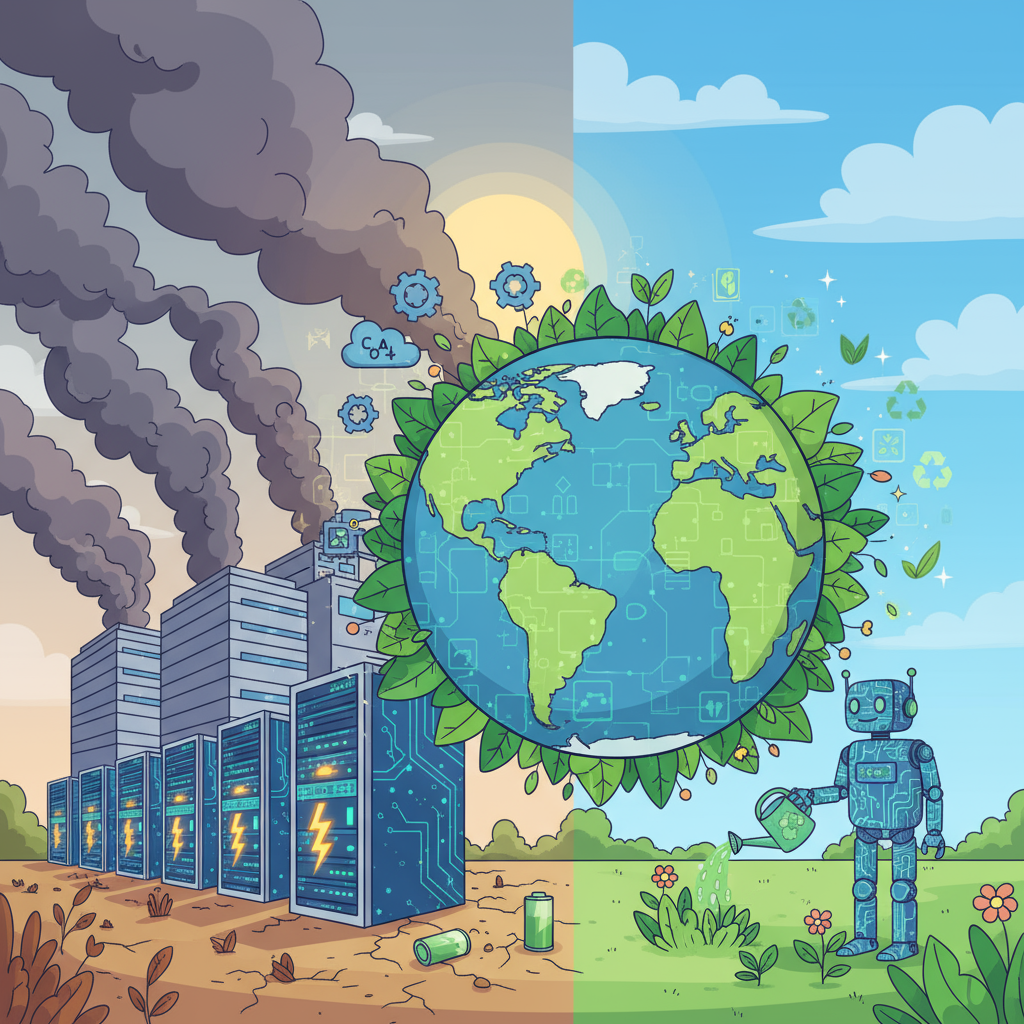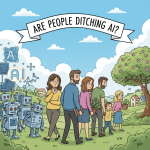Artificial Intelligence (AI) has become the defining technology of our age, powering everything from search engines and medical diagnostics to self-driving cars and personalized ads. But behind this innovation lies a critical question: how bad is AI for the environment?
AI models, especially large-scale ones like GPT, consume enormous computing power, which translates into high energy demand and carbon emissions. For instance, training a single AI model can emit as much carbon as five cars over their entire lifetimes. With AI adoption accelerating across industries and even being integrated into everyday apps, its environmental footprint is becoming impossible to ignore.
Understanding AI’s Environmental Impact
The environmental consequences of AI arise mainly from three key areas: energy consumption, carbon emissions, and e-waste from hardware.
Energy Consumption in AI Training
Training cutting-edge AI models such as GPT or GPT-4 requires thousands of high-performance GPUs running for weeks or months. This is not the same as running a basic app—it is on a far larger scale.
-
A single training run for a state-of-the-art language model can consume megawatt-hours of electricity.
-
According to the University of Massachusetts, training one NLP model can generate 626,000 pounds of CO₂, equivalent to the emissions of 125 round-trip flights from New York to Beijing.
-
Energy requirements continue to rise as models scale up in size and complexity.
Data Centers: The Heart of AI Operations
Data centers house the servers that run and support AI workloads. They are massive facilities that consume significant energy, much of it used in cooling systems to prevent overheating.
-
By 2030, data centers could account for 8% of global energy demand.
-
Regions heavily reliant on coal-powered grids worsen the environmental cost, creating “dirty AI.”
-
Efficient cooling and renewable power adoption can reduce this, but adoption is inconsistent worldwide.
Carbon Emissions and AI
Most of AI’s environmental harm stems from carbon emissions generated by powering and cooling data centers. While tech giants like Google and Microsoft are moving toward carbon neutrality, the overall AI sector still contributes significantly to global greenhouse gases.
-
If unchecked, AI-related carbon emissions could rival those of entire countries.
-
Training an advanced AI on fossil-fuel-heavy grids produces far more emissions than in renewable-driven regions such as Scandinavia.
How Bad Is AI for the Environment Compared to Other Tech?
While AI does have a high environmental footprint, it must be compared with other digital technologies to understand its scale.
| Technology | Energy Intensity | Environmental Concern | Example Impact |
|---|---|---|---|
| AI Model Training | Extremely high | Carbon emissions, e-waste, energy use | Training GPT models emits CO₂ equal to cars over decades |
| Bitcoin Mining | High | Carbon footprint, e-waste | Uses ~120 TWh annually, more than some countries |
| Cloud Computing | Moderate to high | Data center energy use | Increasing global electricity demand |
| Smartphone Use | Low to moderate | E-waste, energy use | Billions of smartphones increase hardware waste |
AI’s impact is especially problematic because it is scaling rapidly in use cases—far beyond gaming, streaming, or cloud computing.
Secondary Benefits: Can AI Be Part of the Solution?
Ironically, while AI creates emissions, it also has the potential to mitigate climate change. AI can be a powerful tool in driving sustainability if applied strategically.
-
Energy Optimization: AI improves energy efficiency in power grids, reducing waste and supporting renewable energy integration.
-
Smart Agriculture: AI-driven solutions optimize irrigation, fertilizer use, and crop cycles to minimize resource consumption.
-
Climate Modeling: Complex simulations and predictive models built with AI help scientists better understand and act upon climate challenges.
-
Green Logistics: AI algorithms minimize transportation emissions by optimizing delivery routes and supply chains.
So while AI currently has a negative footprint, it can also serve as a key enabler for environmental solutions—if balanced properly.
What Industry Leaders Are Doing
Tech giants are well aware of the growing criticism around AI’s environmental impact. Several companies have pledged major sustainability initiatives:
-
Google: Claims to be carbon neutral since 2007 and aims to operate entirely on renewable energy by 2030.
-
Microsoft: Pledged to go carbon-negative by 2030, meaning it will remove more carbon than it emits.
-
OpenAI & Nvidia: Looking at efficiency-focused AI models and AI-specific hardware designed to consume less energy.
-
Meta & Amazon: Moving toward water-positive and zero-carbon operations across their global infrastructures.
The challenge lies in accelerating implementation across all regions, not just where green energy is already dominant.
Steps to Reduce AI’s Environmental Harm
If you’re an AI developer, company leader, or simply a tech user, there are actionable ways to reduce AI’s environmental impact:
-
Adopt energy-efficient models: Instead of giant models, optimize smaller, task-specific AI models.
-
Choose renewable-powered cloud providers: Prioritize hosting services powered by wind, solar, or hydroelectricity.
-
Use transfer learning: Reduces the need for retraining massive models from scratch.
-
Implement carbon accounting: Monitor and offset AI-related energy usage, similar to financial auditing.
-
Promote AI governance frameworks: Push for global standards that balance innovation with sustainability.
The Ethical Dimension: Should We Slow Down AI?
Beyond the technical and industrial aspects, there is a bigger debate: Should humanity slow down AI development until its environmental impact is better managed?
-
Some argue that prioritizing speed and scale is reckless when emissions are so high.
-
Others believe delaying AI innovation could hinder progress in medicine, climate solutions, and energy efficiency.
-
Ultimately, the balance between innovation and sustainability will determine whether AI is a net positive or negative for the planet.
FAQs
1. How bad is AI for the environment compared to Bitcoin mining?
Bitcoin mining still consumes more energy globally, but AI’s footprint is rising quickly. Unlike crypto, AI has practical applications that may offset its environmental impact.
2. Does training AI models always produce huge carbon emissions?
Yes, but the footprint depends on the energy source. Training on renewable-powered grids has far less impact than using fossil fuel grids.
3. Can AI help fight climate change?
Absolutely. AI can optimize energy systems, enable climate modeling, and reduce supply chain emissions. Its potential as a climate tool is enormous if used responsibly.
4. What role can governments play?
Policymakers can encourage greener AI practices by regulating emissions, incentivizing renewable energy, and funding sustainable computing research.
5. Should individuals be concerned about everyday AI use?
Using AI tools for simple tasks (chatbots, image generation) has a smaller footprint than training models. The major concern lies in large-scale training processes by companies.
Conclusion: The Future of AI and the Planet
AI is one of humanity’s greatest technological breakthroughs, but it comes with a hidden environmental cost that cannot be ignored. When asking the question how bad is AI for the environment, the answer is: bad enough to demand urgent action, but not beyond repair.
As AI adoption grows worldwide, balancing innovation with sustainability will be essential. By investing in greener data centers, renewable energy, and efficient AI models, we can ensure AI serves both humanity and the planet.
Call to Action: If you’re an AI practitioner, policymaker, or everyday tech user, start thinking critically about the sustainability of your digital choices. The future of AI—and our environment—depends on it.











